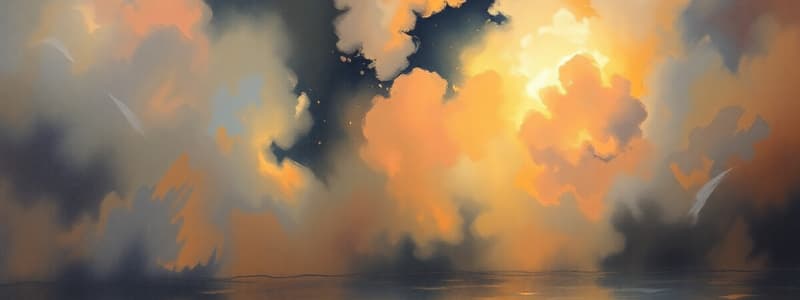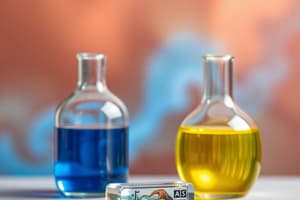Podcast
Questions and Answers
What will happen to the size of a helium balloon as it rises in the air?
What will happen to the size of a helium balloon as it rises in the air?
- The balloon will expand because the gas inside increases in volume. (correct)
- The balloon will remain the same size regardless of altitude.
- The balloon will burst due to increased pressure.
- The balloon will shrink as it gets higher.
Which action would lead to an increase in the pressure of gas in a cylinder with a moveable piston?
Which action would lead to an increase in the pressure of gas in a cylinder with a moveable piston?
- Increasing the volume of the cylinder.
- Decreasing the volume of the cylinder. (correct)
- Removing some of the gas from the cylinder.
- Decreasing the temperature of the gas.
What happens to the balloon's volume if its temperature decreases suddenly?
What happens to the balloon's volume if its temperature decreases suddenly?
- Its pressure will increase drastically.
- Its volume will increase significantly.
- Its volume will decrease as the gas contracts. (correct)
- Its mass will remain unchanged.
What primarily allows a hot-air balloon to rise when the gas inside is heated?
What primarily allows a hot-air balloon to rise when the gas inside is heated?
If two samples of gas have the same volume, temperature, and pressure, what can also be inferred about them?
If two samples of gas have the same volume, temperature, and pressure, what can also be inferred about them?
Which statement best explains why the pilot of a hot-air balloon can change its altitude?
Which statement best explains why the pilot of a hot-air balloon can change its altitude?
If some gas is removed from a cylinder, what will happen to the pressure inside the cylinder?
If some gas is removed from a cylinder, what will happen to the pressure inside the cylinder?
What effect does heating a gas have on the motion of its molecules?
What effect does heating a gas have on the motion of its molecules?
What could cause a change in volume of gas in a cylinder?
What could cause a change in volume of gas in a cylinder?
Which tank contains the greatest number of gas particles?
Which tank contains the greatest number of gas particles?
What does a liquid do when its vapor pressure equals atmospheric pressure?
What does a liquid do when its vapor pressure equals atmospheric pressure?
What principle explains air flow in a prairie dog burrow due to differences in mound heights?
What principle explains air flow in a prairie dog burrow due to differences in mound heights?
What happens to the pressure of gas in an aerosol can when the temperature is raised from 27 °C to 250 °C?
What happens to the pressure of gas in an aerosol can when the temperature is raised from 27 °C to 250 °C?
What phenomenon causes air to flow from one entrance of a prairie dog burrow to another?
What phenomenon causes air to flow from one entrance of a prairie dog burrow to another?
Which of the following best describes the behavior of vapor pressure with increasing temperature for a solution compared to pure water?
Which of the following best describes the behavior of vapor pressure with increasing temperature for a solution compared to pure water?
Rubber plugs in aerosol cans are designed to prevent failure under which condition?
Rubber plugs in aerosol cans are designed to prevent failure under which condition?
What characteristic makes the ideal gas model particularly useful?
What characteristic makes the ideal gas model particularly useful?
Which of the following generalizations is true regarding the relationship between temperature and volume of a gas?
Which of the following generalizations is true regarding the relationship between temperature and volume of a gas?
What remains unchanged when a gas in a sealed cylinder is heated?
What remains unchanged when a gas in a sealed cylinder is heated?
According to Charles's law, what will happen to the piston in a container with a moveable piston when the gas is heated?
According to Charles's law, what will happen to the piston in a container with a moveable piston when the gas is heated?
Which statement about the behavior of gases as temperature increases is true?
Which statement about the behavior of gases as temperature increases is true?
What happens to the average number of gas molecules hitting the walls of a cylinder as the gas is heated?
What happens to the average number of gas molecules hitting the walls of a cylinder as the gas is heated?
If the volume of a gas is held constant, what happens to the pressure as temperature increases?
If the volume of a gas is held constant, what happens to the pressure as temperature increases?
Which factor does not directly affect gas behavior in a closed system?
Which factor does not directly affect gas behavior in a closed system?
What can be directly determined from the provided data about the gas sample?
What can be directly determined from the provided data about the gas sample?
Which graph best illustrates the relationship between pressure and temperature for a gas inside a can?
Which graph best illustrates the relationship between pressure and temperature for a gas inside a can?
Which principle is utilized in the design of the Amundsen-Scott South Pole Research Station?
Which principle is utilized in the design of the Amundsen-Scott South Pole Research Station?
Why does the Amundsen-Scott Research Station have an adjustable elevation?
Why does the Amundsen-Scott Research Station have an adjustable elevation?
What does the design of the station's front slope aim to achieve?
What does the design of the station's front slope aim to achieve?
What environmental condition affects the design of structures at the South Pole?
What environmental condition affects the design of structures at the South Pole?
Which of the following factors is NOT essential in understanding the gas sample's behavior?
Which of the following factors is NOT essential in understanding the gas sample's behavior?
What aspect of gas behavior does the ideal gas law primarily describe?
What aspect of gas behavior does the ideal gas law primarily describe?
What would increase the pressure of the gas below the piston in the glass jar?
What would increase the pressure of the gas below the piston in the glass jar?
What happens when the glass jar is pushed straight down into the water?
What happens when the glass jar is pushed straight down into the water?
What happens to the temperature of the water in a sealed jar containing warm water when placed in a bowl of cold water?
What happens to the temperature of the water in a sealed jar containing warm water when placed in a bowl of cold water?
In which of the following scenarios is the pressure in the test tube greater than the atmospheric pressure?
In which of the following scenarios is the pressure in the test tube greater than the atmospheric pressure?
What would be the result of decreasing the pressure outside the glass jar?
What would be the result of decreasing the pressure outside the glass jar?
How does the temperature of the water in the bowl change when a sealed jar of warm water is immersed?
How does the temperature of the water in the bowl change when a sealed jar of warm water is immersed?
What effect does increasing the temperature of the gas inside the jar have?
What effect does increasing the temperature of the gas inside the jar have?
What occurs when the temperature of the warm water in the jar equilibrates with the cold water in the bowl?
What occurs when the temperature of the warm water in the jar equilibrates with the cold water in the bowl?
Flashcards are hidden until you start studying
Study Notes
Temperature and Volume of a Gas
- As temperature increases, the volume of a gas increases.
- Ideal gas model predicts the behavior of most gas molecules.
Gas Properties and Heating
- Heating a gas increases the average kinetic energy of the gas molecules.
- Heating a gas increases the average speed of the gas molecules.
- Heating a gas increases the average number of gas molecules hitting the container walls per second.
- Heating a gas does not increase the average distance between the gas molecules.
Charles's Law
- Heating a gas in a sealed container causes the gas to expand, pushing the piston upward.
- This happens because the gas particles move faster and get farther apart.
Balloons
- Helium balloons will expand as they rise due to decreasing atmospheric pressure.
- Reducing temperature of a balloon will decrease its volume.
Pressure
- Decreasing the volume of a cylinder containing gas increases the pressure of the gas.
- Removing gas from a cylinder decreases the pressure of the gas.
- Decreasing the pressure outside of a cylinder increases the pressure of the gas inside the cylinder.
Hot Air Balloons
- Heating the air inside a hot air balloon decreases its density, causing it to rise.
Density
- Gas samples with the same volume, temperature, and pressure also have the same number of molecules.
Nitrogen Gas
- The tank with the smallest volume contains the greatest number of gas particles.
Vapor Pressure
- Vapor pressure is the pressure exerted by a vapor in equilibrium with its liquid or solid.
- The vapor pressure of a liquid increases as temperature increases.
- Sucrose dissolved in water lowers the vapor pressure of the solution at a given temperature.
Bernoulli's Principle
- Bernoulli's principle states that an increase in the speed of a fluid decreases the pressure in the fluid.
- The design of the Amundsen-Scott South Pole Research Station utilizes Bernoulli's principle to manage snow accumulation by creating lower pressure zones around the building.
Pressure and Temperature
- Pressure and temperature of a gas have a direct relationship: as temperature increases, pressure increases.
Water Pressure
- Water pressure increases with depth.
- The greater the depth of the water, the greater the pressure.
Atmospheric Pressure
- A system is at atmospheric pressure when the pressure inside the system is equal the pressure outside.
- A system is at greater than atmospheric pressure when the pressure inside the system is higher than the pressure outside.
Conduction
- Conduction is the transfer of heat through direct contact between substances.
- Heating a glass jar containing warm water in a bowl of cold water causes the temperature of the warm water to decrease and the temperature of the cold water to increase.
Aerosol Cans
- Rubber plugs are used in aerosol cans to prevent structural failure caused by an increase in pressure due to heat.
Studying That Suits You
Use AI to generate personalized quizzes and flashcards to suit your learning preferences.




